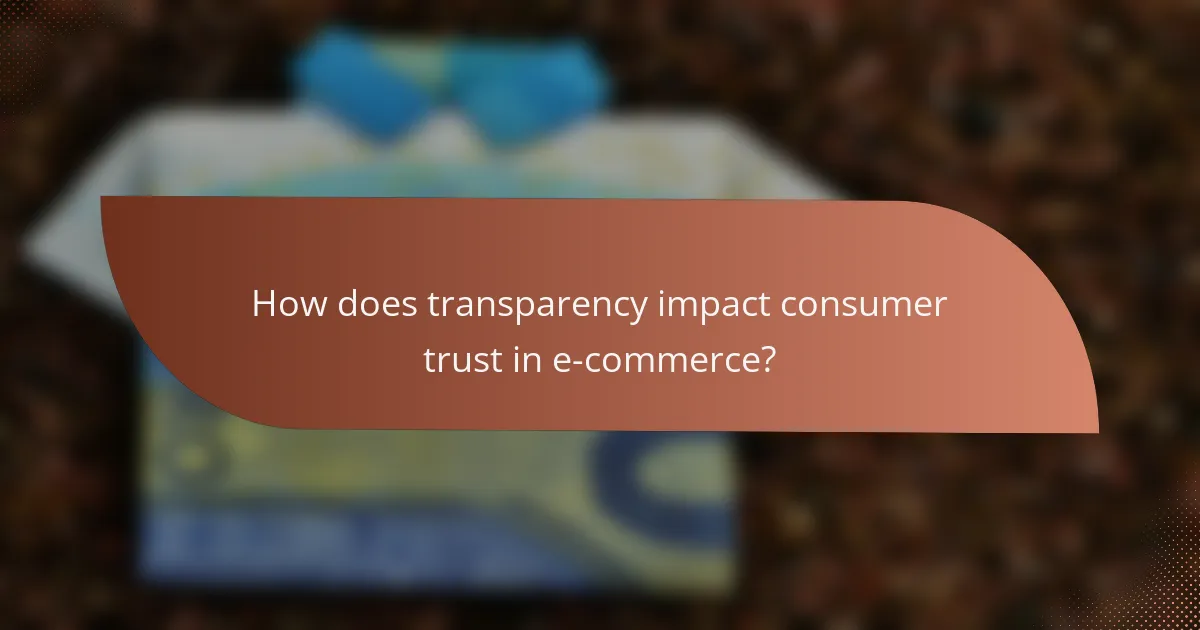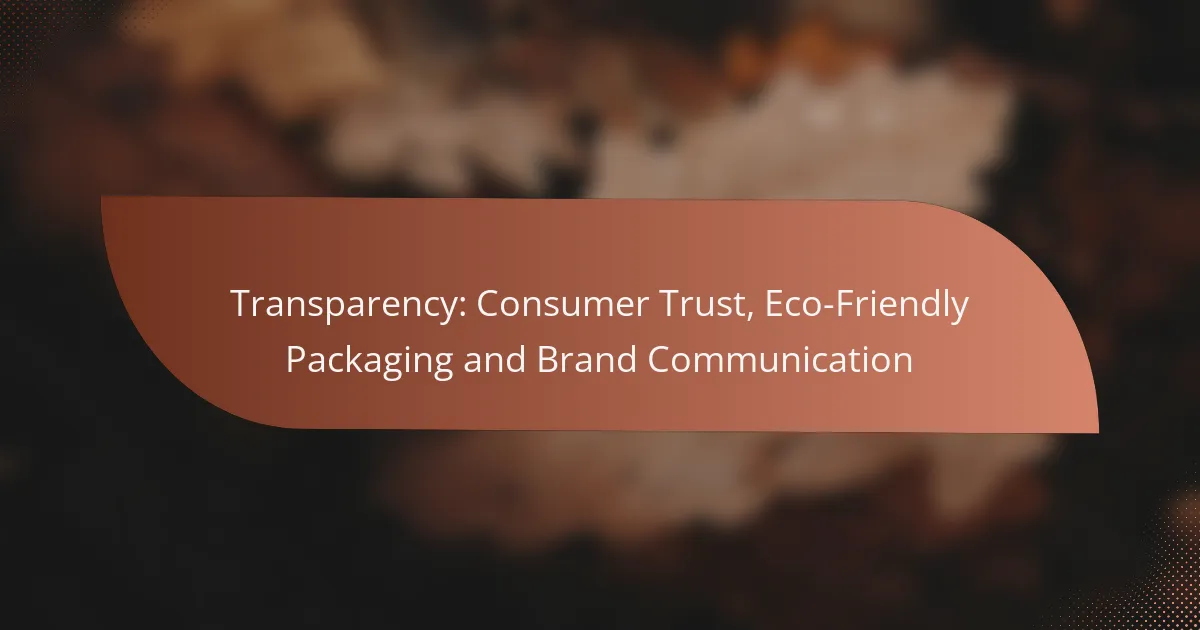In today’s market, transparency plays a crucial role in building consumer trust, particularly in e-commerce. By openly communicating about sourcing, production methods, and environmental impact, brands can foster confidence among consumers. Additionally, adopting eco-friendly packaging not only enhances this trust but also appeals to a growing demographic of environmentally conscious shoppers, setting brands apart in a competitive landscape.

How does transparency impact consumer trust in e-commerce?
Transparency significantly enhances consumer trust in e-commerce by fostering open communication about products and practices. When brands openly share information regarding sourcing, production methods, and environmental impact, consumers feel more confident in their purchasing decisions.
Increased brand loyalty
Transparent communication can lead to increased brand loyalty as consumers develop a stronger emotional connection with brands that align with their values. When customers know a brand is committed to ethical practices, they are more likely to return for future purchases.
For example, brands that disclose their sustainability efforts or fair trade practices often see repeat business from eco-conscious consumers. This loyalty can translate into long-term revenue growth, as satisfied customers may also recommend the brand to others.
Enhanced customer satisfaction
Transparency contributes to enhanced customer satisfaction by setting clear expectations and delivering on promises. When consumers receive accurate information about product features, pricing, and delivery times, they are less likely to experience disappointment.
Additionally, brands that are upfront about their policies, such as return or warranty processes, can reduce confusion and frustration. This clarity not only improves the shopping experience but also encourages positive reviews and referrals, further boosting the brand’s reputation.

What are the benefits of eco-friendly packaging for brands?
Eco-friendly packaging offers brands significant advantages, including enhanced consumer trust and reduced environmental impact. By adopting sustainable materials and practices, companies can differentiate themselves in a competitive market and appeal to a growing demographic of environmentally conscious shoppers.
Reduced environmental impact
Using eco-friendly packaging minimizes waste and lowers carbon emissions, contributing to a healthier planet. Brands can choose materials that are biodegradable, recyclable, or made from renewable resources, which helps reduce landfill contributions and resource depletion.
For example, switching from plastic to paper or plant-based packaging can significantly cut down on pollution. Many brands are now adopting practices that align with global sustainability goals, such as the European Union’s regulations on single-use plastics, which encourage the use of more sustainable packaging solutions.
Attracts eco-conscious consumers
Eco-friendly packaging resonates with consumers who prioritize sustainability in their purchasing decisions. Brands that showcase their commitment to the environment often see increased loyalty and sales from this demographic, which is becoming increasingly influential.
To effectively attract eco-conscious shoppers, brands should clearly communicate their sustainable practices through labeling and marketing. Highlighting certifications, such as FSC (Forest Stewardship Council) or Cradle to Cradle, can further enhance credibility and appeal.

How can brands communicate transparency effectively?
Brands can communicate transparency effectively by openly sharing information about their practices, sourcing, and product ingredients. This builds consumer trust and fosters loyalty, especially when consumers are increasingly concerned about ethical and eco-friendly practices.
Utilizing social media platforms
Social media platforms are powerful tools for brands to showcase transparency. By sharing behind-the-scenes content, brands can engage consumers and illustrate their commitment to ethical practices. Regular updates and interactive content, such as Q&A sessions, can further enhance trust.
Brands should consider using platforms like Instagram and Facebook to highlight eco-friendly initiatives or sourcing stories. Engaging with followers through comments and messages also provides a direct line of communication, allowing for real-time feedback and transparency.
Implementing clear labeling practices
Clear labeling practices are essential for effective communication of transparency. Brands should ensure that product labels include comprehensive information about ingredients, sourcing, and environmental impact. This allows consumers to make informed choices based on their values.
For example, using recognizable symbols for eco-friendly certifications can help consumers quickly identify sustainable products. Additionally, brands should avoid jargon and ensure that labels are easy to read and understand, catering to a diverse audience.

What are the best practices for eco-friendly packaging?
Best practices for eco-friendly packaging focus on using sustainable materials and reducing waste. Brands can enhance consumer trust and demonstrate commitment to the environment by adopting these practices.
Using biodegradable materials
Biodegradable materials break down naturally over time, reducing landfill waste and environmental impact. Common options include plant-based plastics, paper, and compostable materials that decompose within a few months to a couple of years.
When selecting biodegradable options, consider certifications like ASTM D6400 or EN 13432, which indicate compliance with compostability standards. Brands should also communicate the biodegradability of their packaging clearly to consumers to build trust.
Minimizing packaging waste
Minimizing packaging waste involves designing packaging that uses fewer materials while still protecting products. Techniques include optimizing package sizes, using minimalistic designs, and eliminating unnecessary components.
Brands can adopt practices such as using reusable packaging systems or offering incentives for customers who return packaging. Additionally, consider using recyclable materials and clearly labeling them to encourage proper disposal, which can significantly reduce overall waste and enhance brand reputation.

How do consumers perceive brand transparency in major US cities?
Consumers in major US cities generally expect high levels of brand transparency, viewing it as essential for trust and loyalty. This perception is influenced by factors such as local culture, awareness of sustainability issues, and the prevalence of eco-friendly practices.
Higher expectations in urban areas
Urban consumers often have heightened expectations for transparency due to greater access to information and a more diverse marketplace. They tend to scrutinize brands more closely, seeking clear communication about sourcing, production practices, and environmental impact.
For example, brands that openly share their sustainability efforts, such as using recycled materials or reducing carbon footprints, are more likely to build trust with city dwellers. Transparency in labeling and marketing can significantly influence purchasing decisions in these areas.
Influence of local regulations
Local regulations in major cities can shape consumer expectations around transparency. Many urban areas have implemented strict guidelines regarding labeling and environmental claims, which compel brands to provide accurate information about their products.
For instance, cities like San Francisco and New York have adopted policies that promote eco-friendly packaging and require clear disclosures about product ingredients. Brands that comply with these regulations not only avoid penalties but also enhance their reputation among consumers who prioritize ethical practices.

What frameworks can brands use to measure transparency?
Brands can utilize various frameworks to measure transparency, including consumer feedback surveys and transparency scorecards. These tools help assess how openly a brand communicates its practices and policies, fostering consumer trust and loyalty.
Consumer feedback surveys
Consumer feedback surveys are a direct method for brands to gauge their transparency from the perspective of their customers. By asking targeted questions about packaging, sourcing, and sustainability practices, brands can collect valuable insights into consumer perceptions and expectations.
When designing these surveys, consider including questions that address specific aspects of transparency, such as clarity of information and ease of access to details. Aim for a response rate of at least 10-20% to ensure the data is representative.
Transparency scorecards
Transparency scorecards provide a structured way to evaluate and communicate a brand’s transparency efforts. These scorecards typically assess various criteria, such as ingredient sourcing, environmental impact, and ethical labor practices, assigning scores that reflect performance.
To create an effective scorecard, identify key metrics relevant to your industry and set benchmarks based on best practices. Regularly update the scorecard to reflect improvements or changes in transparency initiatives, and share the results publicly to enhance credibility.

What are the challenges of implementing transparency?
Implementing transparency in business practices can be complex due to various factors, including costs, competitive dynamics, and consumer expectations. Companies must navigate these challenges while striving to build trust and demonstrate commitment to eco-friendly practices.
Cost of sustainable materials
The cost of sustainable materials often exceeds that of conventional options, creating a financial hurdle for brands aiming for transparency. For instance, eco-friendly packaging can be 20-50% more expensive, which may impact pricing strategies and profit margins.
Brands should consider the long-term benefits of investing in sustainable materials, such as enhanced consumer loyalty and reduced environmental impact. Conducting a cost-benefit analysis can help determine if the investment aligns with the company’s values and market positioning.
Balancing transparency with competitive advantage
While transparency can enhance consumer trust, it may also expose sensitive information that competitors could exploit. Companies must find a balance between sharing enough to satisfy consumer demands and protecting proprietary information that contributes to their competitive edge.
To navigate this challenge, brands can focus on communicating their sustainability efforts without revealing specific formulas or processes. Highlighting certifications, sourcing practices, and overall environmental impact can provide transparency while maintaining a competitive stance.

How does transparency influence purchasing decisions?
Transparency significantly impacts purchasing decisions by fostering consumer trust and loyalty. When brands openly share information about their practices, ingredients, and sourcing, customers are more likely to feel confident in their choices and support those companies.
Consumer Trust
Consumer trust is built on the foundation of honesty and openness. Brands that provide clear information about their products, including sourcing and manufacturing processes, tend to attract more loyal customers. For instance, a company that discloses its supply chain practices is likely to earn the trust of consumers who prioritize ethical sourcing.
To enhance trust, companies should consider using third-party certifications that validate their claims. This can include eco-labels or fair trade certifications, which signal to consumers that the brand adheres to recognized standards.
Eco-Friendly Packaging
Eco-friendly packaging plays a crucial role in transparency and sustainability. Brands that use recyclable or biodegradable materials demonstrate their commitment to environmental responsibility, which can positively influence consumer perceptions. For example, a product packaged in compostable materials may appeal to environmentally conscious shoppers.
When selecting packaging, companies should clearly communicate the environmental benefits to consumers. Simple labels that explain how to recycle or dispose of packaging can further enhance transparency and encourage responsible consumer behavior.
Brand Communication
Effective brand communication is essential for conveying transparency. Brands should utilize various channels, such as social media, websites, and product labels, to share information about their practices and values. Regular updates and engaging content can help maintain consumer interest and trust.
Additionally, brands should be prepared to address consumer questions and concerns openly. This proactive approach not only builds credibility but also fosters a sense of community among consumers who share similar values regarding transparency and sustainability.
